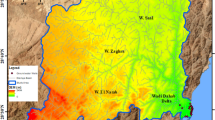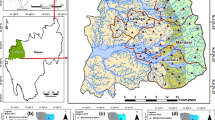Abstract
Geochemical and isotopic investigations were carried out in the Tapi Valley geothermal area in India to determine the principal factors that are responsible for the geochemical evolution of the thermal and non-thermal waters in the study area. The impact of thermal water discharges on the surrounding potable water resources had also been assessed. It was found that thermal water did not contain any toxic elements (mercury, antimony, arsenic) which are detrimental to human consumption. Thermal waters were found to be less mineralized compared to the non-thermal ground waters. The water types of the thermal and non-thermal waters were found to be mostly Na–Cl–HCO3 and Ca–Mg–HCO3, respectively. Silicate weathering and ion-exchange processes were found to be main factors that determined the dissolved solute concentration in the study area. Stable isotopic (δ18O, δ2H) analysis unequivocally established the meteoric origin of the thermal waters. Thermal waters in Unapdeo, Anekdev, Kundwa and Ratanpura were found to have distinct isotopic compositions signifying that separate reservoirs were feeding these hot springs. The application of chemical geothermometers showed a wide variation in the estimation of reservoir temperature. The quartz geothermometer produced the most reliable reservoir temperature estimate of 110 ± 12 °C. Multicomponent geothermometry was found to better constrain the reservoir temperature. This modelling result indicated that the thermal water in this region had attained simultaneous equilibrium with respect to quartz, aragonite, stilbite, calcite, enstatite, heulandite, diopside minerals in the temperature range of 120 ± 5 °C which could be taken as the subsurface reservoir temperature.










Similar content being viewed by others
Availability of data and material
All the data and material are provided in the manuscript only.
Code availability
GeoT computer code used to calculate multicomponent geothermometry calculation can be accessed through https://eesa.lbl.gov/technology/geot/.
References
Ali Khan T (2015) Groundwater quality evaluation using multivariate methods, in parts of Ganga Sot Sub-Basin, Ganga Basin, India. J Water Resour Prot 7:769–780
APHA (American Public Health Association) (1995) Standard methods for the examination of water and wastewater, 19th edn. American Public Health Association, Washington, DC, pp 4–122
Arnorsson S (1983) Chemical equilibria in Icelandic geothermal systems-implications for chemical geothermometry investigations. Geothermics 12:119–128
BIS (1991) Specifications for drinking water, IS:10500:1991. Bureau of Indian Standards, New Delhi, India
Brown KL, Simmons SF (2003) Precious metals in high temperature geothermal systems in New Zealand. Geothermics 32:619–625
Chatterjee S, Sharma S, Ansari A, Deodhar AS, Low U, Sinha UK, Dash A (2016) Characterization of subsurface processes estimation of reservoir temperature in Tural and Rajwadi geothermal fields, Maharashtra, India. Geothermics 59:77–89
Chatterjee S, Ansari MA, Deodhar AS, Sinha UK, Dash A (2017) A multi-isotope approach (O, H, C, S, B and Sr) to understand the source of water and solutes in some the thermal springs from West Coast geothermal area. India Arab J Geosci 10:242
Chatterjee S, Gusyev MA, Sinha UK, Mohokar HV, Dash A (2019a) Understanding water circulation with tritium tracer in the Tural-Rajwadi geothermal area India. Appl Geochem 109:104373
Chatterjee S, Sinha UK, Biswal BP, Jaryal A, Jain PK, Patbhaje S, Dash A (2019b) An integrated isotope-geochemical approach to characterize a medium enthalpy geothermal system in India. Aquat Geochem 25:63–89
Chatterjee S, Sinha UK, Biswal BP, Jaryal A, Patbhaje S, Dash A (2019c) Multicomponent versus classical geothermometry: applicability of both geothermometers in a medium-enthalpy geothermal system in India. Aquat Geochem 25:91–108
Courtillot V, Jaupart C, Manegheeti I, Tapponnier P, Besse J (1999) On casual links between flood basalts and continental breakup. Earth Planet Sci Lett 166:177–195
Deshpande RD, Bhattacharya SK, Jani RA, Gupta SK (2003) Distribution of oxygen and hydrogen isotopes in shallow ground waters from southern India: influence of a dual monsoon system. J Hydrol 271:226–239. https://doi.org/10.1016/S0022-1694(02)00354-2
Dubey R, Saxena RK (1987) Thermal springs and associated tectonics of Tapi basin area. Dist. Dhulia and Jalgaon, Maharashtra. Geol Surv Ind Rec 115(6):150–174
Epstein S, Mayeda T (1953) Variation of 18O contents of water from natural sources. Geochim Cosmochim Acta 4:213–224
Fournier RO (1977) Chemical geothermometers and mixing models for geothermal systems. Geothermics 5:40–41
Fournier RO (1979) A revised equation for Na/K geothermometer. Trans Geotherm Resour Counc 3:221–224
Fournier RO, Potter RW (1979) Magnesium correction to the Na-K-Ca chemical geothermometer. Geochim Cosmochim Acta 43:1543–1550
Fournier RO, Truesdell AH (1973) An empirical Na-K-Ca geothermometer from natural waters. Geochim Cosmochim Acta 37:1255–1275
Gaillardet J, Dupre B, Louvat P, Allegre CJ (1999) Global silicate weathering and CO2 consumption rates deduced from the chemistry of large rivers. Chem Geol 159:3–30
Geological Survey of India (1987) A collection of geothermal papers. Geol Surv Ind Rec 115:1–206
Geological Survey of India (1991) Geothermal atlas of India. Geol Surv Ind Spl Pub 19:1–144
Giggenbach WF (1988) Geothermal solute equilibria. Derivation of Na–K–Mg–K geoindicators. Geochim Cosmochim Acta 52:2749–2765
Giggenbach WF (1992) Isotopic shift in waters from geothermal and volcanic systems along convergent plate boundaries and their origin. Earth Planet Sci Lett 113:495–510
Jain SC, Nair KKK, Yedekar DB (1995) Geology of Son-Narmada-Tapti lineament zone in central India. Geol Surv Ind Spl Pub 10:1–154
Jain CK, Bandyopadhyay A, Bhadra A (2010) Assessment of ground water quality for drinking purpose, District Nainital, Uttarakhand, India. Environ Monit Assess 166:663–676
Jankowski J, Acworth RI, Shekarforoush S (1998) Reverse ion exchange in deeply weathered porphyritic dacite fractured aquifer system, Yass, New South Wales, Australia. In: Arehart GB, Hulston JR (eds) Ninth internat symp water-rock interaction. A.A. Balkema, Rotterdam, pp 243–246
Kumar A, Singh CK (2015) Characterization of hydrogeochemical processes and fluoride enrichment in groundwater of south-western Punjab. Water Qual Expo Health 7(3):373–387. https://doi.org/10.1007/s12403-015-0157-7
Li J, Wang Y, Xie X, Su C (2012) Hierarchical cluster analysis of arsenic and fluoride enrichments in groundwater from the Datong basin, Northern China. J Geochem Explor 118:77–89
Minissale AO, Vaselli D, Chandrasekharam G, Magro F, Tassi A, Casiglia (2000) Origin and evolution of ‘intracratonic’ thermal fluids from central-western peninsular India. Earth Planet Sci Lett 181(3):377–394. https://doi.org/10.1016/S0012-821X(00)00200-4
Mroczek EK (2005) Contributions of arsenic and chloride from the Kawerau geothermal field to the Tarawera River, New Zealand. Geothermics 34:218–233
Mukherjee A, Fryar AE (2008) Deeper groundwater chemistry and geochemical modeling of the arsenic affected western Bengal basin, West Bengal. India Appl Geochem 23:863–892
Mukherjee A, Bhattacharya P, Shi F, Fryar A, Mukherjee AB, Xie ZM, Jacks G, Bundschuh J (2009) Chemical evolution in the high arsenic groundwater of the Huhhot basin (Inner Mongolia, PR China) and its difference from the western Bengal basin (India). Appl Geochem 24:1835–1851
Muthuraman K (1987) Geochemistry of thermal waters of west coast, Maharashtra, based on sea water-basalt experimental interaction studies. Geol Surv Ind Rec 115:137–149
Nieva D, Nieva R (1987) Developments in geothermal energy in Mexico, Part 12. A cationic geothermometer for prospecting of geothermal resources. Heat Recovery Syst CHP 7:243–258
Pang ZH, Reed MH (1998) Theoretical chemical thermometry on geothermal waters: problems and methods. Geochim Cosmochim Acta 62:1083–1091
Parkhurst DL, Appelo CAJ (1999) User’s guide to PHREEQC (Version 2)—A computer program for speciation, batch-reaction, one-dimensional transport, and inverse geochemical calculations. In: Water resources investigations report 99–4259. U.S. geological survey, Washington DC
Pitale UL, Dubey R, Saxena RK, Prasad JM, Muthuraman K, Thussu JL, Sharma SC (1987) Review of geothermal studies of west coast hot spring belt. Maharashtra Geol Surv Ind Rec 115:97–136
Rao VK, Nair KKK, Srirama BV, Padhi RN (1996) Geophysical evaluation of structure and geothermal regime in Tapti valley. Geol Surv Ind Spl Pub 45:333–339
Reddy DV, Nagabhushanam P, Ramesh G (2013) Turnover time of Tural and Rajvadihot spring waters, Maharashtra, India. Curr Sci 104(10):1419–1424
Reed MH, Spycher NF (1984) Calculation of pH and mineral equilibria in hydrothermal waters with application to geothermometry and studies of boiling and dilution. Geochim Cosmochim Acta 48:1479–1492
Roques C, Aquilina L, Bour O, Maréchal JC, Dewandel B, Pauwels H, Hochreutener R (2014) Groundwater sources and geochemical processes in a crystalline fault aquifer. J Hydrol 519:3110–3128
Shanker R (1987) Status of geothermal exploration in Maharashtra and Madhya Pradesh (Central India). Geol Surv Ind Rec 115(6):7–29
Singh CK, Kumari R, Singh RP, Mukherjee S (2014) Geochemical characterization and heavy metal contamination of groundwater in Satluj River Basin. Environ Earth Sci 71:201–216. https://doi.org/10.1007/s12665-013-2424-x
Smedley PL, Kinniburgh DG (2002) A review of the source, behaviour and distribution of arsenic in natural waters. Appl Geochem 17:517–568
Spycher N, Peiffer L, Sonnenthal E, Saldi G, Reed MH, Kennedy BM (2014) Integrated multicomponent solute geothermometry. Geothermics 51:113–123
Tonani F (1980) Some remarks on the application of geochemical techniques in geothermal exploration. In: Proceedings Adv. Eur. Geoth. Res., Second symp., Strasbourg, pp 428–443
Webster JG (1999) The source of arsenic (and other elements) in the Marbel-Matingao river catchment, Mindanao, Philippines. Geothermics 28:95–111
Xu T, Hou Z, Jia X, Spycher N, Jiang Z, Feng B, Na J, Yuan Y (2016) Classical and integrated multicomponent geothermometry at the Tengchong geothermal field. Southwestern China Environ Earth Sci 75:1502
Acknowledgements
The authors wish to acknowledge Dr. H.J. Pant, Head, IRAD for his support and encouragement during the study. The authors would like to thank all the officers of GSI associated with this project for their active co-operation in this study.
Funding
No funding information is available in this research work.
Author information
Authors and Affiliations
Contributions
Mr. Sitangshu Chatterjee conceptualised the framework of the draft, analysed the isotopic parameters and written the manuscript. Mr. B.P. Biswal carried out the fieldwork, collected geological and hydro-geological information, prepared requisite maps. Dr. U.K. Sinha and S.D. Patbhaje had supervised the whole project.
Corresponding author
Ethics declarations
Conflict of interest
The authors declare no conflict of interest.
Additional information
Publisher's Note
Springer Nature remains neutral with regard to jurisdictional claims in published maps and institutional affiliations.
Supplementary Information
Below is the link to the electronic supplementary material.
Rights and permissions
About this article
Cite this article
Chatterjee, S., Biswal, B.P., Sinha, U.K. et al. Isotope-geochemical assessment of thermal waters and their impact on surrounding potable water resources in the Tapi valley geothermal area, Maharashtra, India. Environ Earth Sci 80, 424 (2021). https://doi.org/10.1007/s12665-021-09709-0
Received:
Accepted:
Published:
DOI: https://doi.org/10.1007/s12665-021-09709-0




